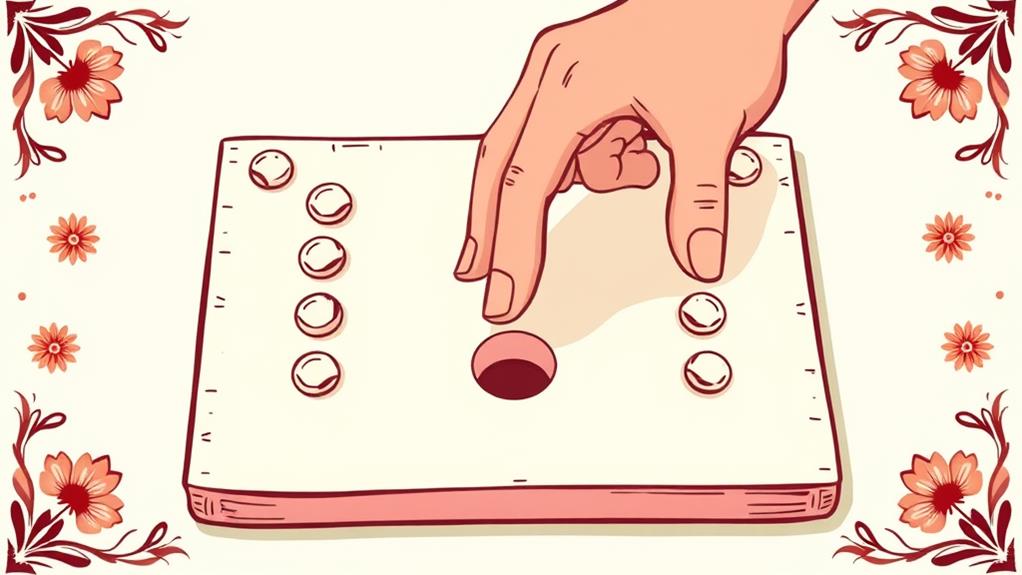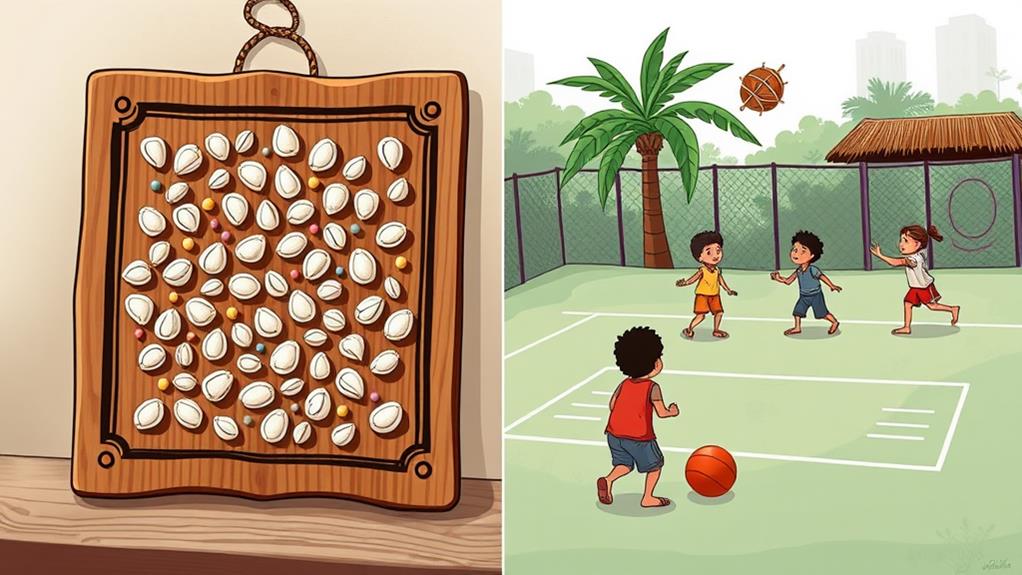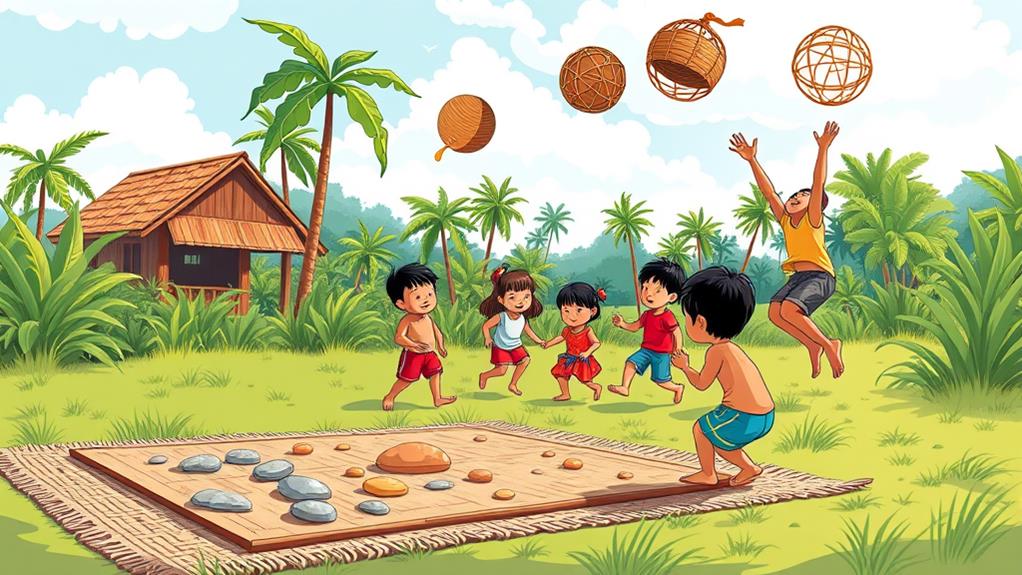Traditional Filipino games like Sungka, Patintero, and Sipa are important parts of the country's cultural heritage. These games have been passed down through generations, teaching cultural values and preserving cultural identity. They also educate children about history and folklore, and bridge generational gaps.
Sungka is a game that requires strategy and critical thinking. Players must think carefully about their moves to win, making it an excellent way to develop problem-solving skills.
In Sungka, players move stones or shells around a board, trying to capture more pieces than their opponent. This game is often played by adults and children together, promoting family bonding and social interaction.
Patintero is a high-energy game that requires teamwork and quick thinking. Players must work together to tag each other while avoiding being tagged themselves.
In Patintero, two teams of players stand in lines, trying to tag each other while avoiding being tagged themselves. This game is an excellent way to promote physical fitness and coordination.
Sipa is a game that requires agility and coordination. Players must hit a small object with their feet, similar to hacky sack.
In Sipa, players hit a small rattan ball with their feet, trying to keep it in the air as long as possible. This game is an excellent way to promote physical fitness and hand-eye coordination.
These traditional Filipino games continue to play a vital role in community bonding and cultural expression. They bring people together, promote social interaction, and preserve cultural heritage.
By playing these games, people can learn about Filipino culture and history, and develop important skills like critical thinking and teamwork.
Cultural Significance of Games
Traditional Filipino games hold significant cultural value. These games, such as Sungka, Patintero, and Sipa, are more than just entertainment; they play a crucial role in instilling cultural values and promoting a sense of community among players.
The blend of indigenous and colonial influences in these games showcases the diversity and richness of Filipino heritage.
Engaging in traditional games helps children learn about their history and folklore, which helps preserve cultural identity. For example, Sungka, a game of shells, teaches children about the importance of strategy and critical thinking.
Social interaction fostered by these games encourages teamwork and cooperation, essential skills for community building. In Patintero, a game of tag, children learn to work together to outmaneuver their opponents.
Traditional games serve as a bridge between generations, allowing elders to pass down cultural knowledge and practices to the youth. This transmission of cultural values helps to preserve cultural knowledge and traditions.
In conclusion, traditional Filipino games aren't just fun activities, but also a means of transmitting cultural values and preserving cultural knowledge.
Types of Traditional Filipino Games
Traditional Filipino games can be categorized into three main types: Larong Bahay, Street Games, and Festival Games. These categories reflect distinct social contexts and play environments.
Larong Bahay refers to indoor games played at home, often requiring minimal equipment. Sungka, a popular Filipino board game, is an example of a Larong Bahay game. It involves moving stones or beads around a wooden board, requiring strategy and skill.
Street Games are outdoor games played in public spaces, such as streets, parks, or playgrounds. Patintero, a high-energy game, is a classic example of a Street Game. It involves two teams trying to outmaneuver each other, with one team attempting to cross the opponent's territory without getting caught.
Festival Games are played during local festivities and cultural events. These games often involve community participation and showcase Filipino culture. Examples of Festival Games include Pinoy Henyo, a guessing game, and Trip to Jerusalem, a musical chair game.
Game Classification Systems
Traditional Filipino games can be categorized into three main classification systems, each reflecting the country's diverse cultural heritage and offering unique gameplay experiences.
Larong Bahay games are typically played indoors and require strategy and skill. Examples of these games include Sungka and Dama, which involve clever thinking and problem-solving, making them a great way to develop critical thinking.
Street Games are played outdoors and emphasize physical activity, teamwork, and community interaction. Examples of these games include Patintero and Luksong Tinik, which promote social bonding and physical fitness by utilizing available materials.
Festival Games are often played during local fiestas and celebrations, highlighting cultural traditions and community spirit. Examples of these games include Palo Sebo and Tug of War, which showcase the cultural significance of traditional Filipino games.
Outdoor Play Variations
Beyond indoor games, traditional Filipino outdoor play variations offer a unique brand of excitement and entertainment.
These games often involve team dynamics, requiring players to work together and think strategically.
Patintero is a notable example, where players must cross lines while avoiding being tagged by defenders, promoting agility and quick thinking.
Another example is Sipa, the national sport, which involves kicking a washer or rattan ball to keep it airborne, emphasizing agility and coordination in a competitive setting.
Tumbang Preso is another outdoor game that incorporates elements of strategy and physical skill, where players hit a tin can with slippers while racing to a designated base.
Luksong Tinik requires players to jump over obstacles created by others, promoting physical fitness and teamwork.
Even Sungka, typically played indoors, can be adapted for outdoor settings, where players capture more seeds than the opponent using strategic placement and moves.
Sungka: Game Mechanics and Strategies

Game Overview
The Sungka board consists of a wooden slate with 14 holes, divided into two rows of seven holes called "bahay." The game starts with 49 small pebbles or shells distributed evenly between the two rows. The objective is to capture more seeds than your opponent by strategically moving them around the board.
Game Mechanics
The game is played in turns, with each player scooping seeds from one hole and distributing them counter-clockwise. The goal is to land the last seed in your bahay, which allows you to capture the seeds in that hole. The game ends when all seeds are captured.
Strategies
To win, anticipate your opponent's next move and calculate your moves to land in your bahay. Adapt your strategy based on your opponent's moves, and use critical thinking to outmaneuver them.
Regularly playing Sungka enhances mathematical skills, such as counting and basic arithmetic.
Gameplay and Benefits
Sungka is typically played by two players but can be adapted for more players, making it an excellent addition to family gatherings or community events.
Playing Sungka develops critical thinking and mathematical skills, making it an engaging and educational traditional Filipino game.
Patintero: Game Overview and Variations
Patintero: A Traditional Filipino Game of Strategy and Speed
In Patintero, two teams compete in a classic Filipino outdoor game that requires speed, strategy, and cunning. The game takes place on a rectangular grid marked on the ground, with two parallel lines serving as the boundary for the defenders.
Key Skills for Success
To succeed in Patintero, players must employ various tactics to evade tagging, including:
Feints and Misdirection: Quick movements are used to deceive opponents and create opportunities to cross the grid. For example, a player might pretend to move in one direction, then suddenly change course to evade a defender.
Teamwork and Communication: Players must coordinate with their teammates to distract opponents and create openings. This can be achieved by having one player create a diversion while another player makes a break for the other side of the grid.
Adapting to Variations: Players must be prepared to adjust their strategy based on local rules and modifications that can alter gameplay dynamics. For instance, some variations may allow players to use obstacles to evade tagging, while others may have additional rules for scoring points.
Benefits of Playing Patintero
Playing Patintero develops essential skills like teamwork, communication, and physical fitness, making it an integral part of Filipino cultural heritage.
This outdoor game has been enjoyed by Filipino children for generations, promoting a sense of community and camaraderie.
Sipa: History and Cultural Impact

Sipa's Rich Cultural Heritage
Sipa, a traditional Filipino game, holds a special place in the country's cultural heritage. Its origins date back to pre-colonial times, showcasing the Filipino community's creativity in utilizing available materials for play, such as using a washer or rattan ball.
Reflecting Cultural Heritage and History
Sipa reflects the country's rich cultural heritage and history of indigenous games. The game emphasizes agility and coordination through kicking, promoting physical fitness and overall well-being.
Fostering Community and Social Interaction
Engaging in Sipa fosters a sense of community as players engage in teamwork and shared experiences, enriching their understanding of cultural expression.
The game encourages social interaction and teamwork, making it a popular choice among children and communities during outdoor gatherings.
Preserving Cultural Significance
Sipa's cultural impact is further solidified by its adaptation into various formats, including competitive tournaments, which help preserve its cultural significance and promote physical fitness among the youth.
Traditional Games for Physical Fitness
Traditional Filipino Games for Physical Fitness
Engaging in traditional Filipino games like Sungka, Patintero, Sipa, and Luksong Tinik is a fun and interactive way to improve physical fitness. These games require strategic movements, hand-eye coordination, and cardiovascular endurance, making them an excellent way to celebrate cultural heritage and promote a sense of community among participants.
Improved Physical Fitness
Traditional Filipino games can improve physical fitness in three ways:
1. Enhanced Coordination and Agility
Games like Patintero and Sungka require quick reflexes and rapid movements, which can improve hand-eye coordination and agility. For instance, Patintero involves dodging and catching balls, enhancing reaction time and fine motor skills.
2. Increased Cardiovascular Endurance
Outdoor games like Luksong Tinik and Sipa involve running, jumping, and kicking, which can boost cardiovascular endurance and overall fitness level. Luksong Tinik, for example, requires players to jump over a series of lines, increasing heart rate and improving cardiovascular health.
3. Improved Lower Body Strength
Playing Sipa, which involves kicking a washer, can strengthen lower body muscles, including legs and glutes. Regularly playing Sipa can lead to improved muscle tone and overall lower body strength.
Social Benefits
These traditional games promote teamwork and cooperation, encouraging players to work together to achieve a common goal.
This social aspect can motivate individuals to engage in physical activity more regularly, leading to a healthier lifestyle. By playing together, individuals can develop a sense of camaraderie and accountability, making physical fitness more enjoyable and sustainable.
Strategy and Guessing Games

Traditional Filipino strategy and guessing games require skill, wit, and social interaction, providing entertainment and reflecting the country's rich cultural heritage. Pitik-Bulag is a classic example, where players must use keen observation and deduction to identify who flicked them. In this game, players are blindfolded and must rely on their sense of touch to figure out who touched them, promoting social interaction and clever guessing techniques.
In contrast, games like Bulong-Pari emphasize teamwork and clever tactics. In this game, one player whispers a message to another, and the other players must work together to uncover the identity of the whispered player. This game requires strategic thinking, effective communication, and problem-solving skills.
Guessing Techniques
Traditional Filipino games often involve guessing techniques, which challenge players to think critically and strategically. These games require players to think on their feet, making them an excellent way to develop problem-solving skills and reflexes.
To excel in these games, players must employ various guessing techniques. Observation is one technique, where players pay attention to subtle cues, like body language and tone of voice, to gain an advantage. For example, in Patay Patayan, players observe their opponents' reactions to guess who's the "killer".
Deductive reasoning is another technique, where players use logic to eliminate possibilities and narrow down options. In Pitik-Bulag, players use deductive reasoning to figure out who's the "stone" by process of elimination.
Pattern recognition is also essential, where players identify patterns in their opponents' behavior to anticipate their next move. In Jack n Poy, players recognize patterns in their opponents' throwing styles to guess where the ball will land.
Games like Agawan Base and Langit-Lupa also require strategy and guessing, as players must navigate to safety while avoiding being tagged by their opponents.
Bulong-Pari Strategies
Bulong-Pari Strategies
Effective Communication is Key
In the traditional Filipino guessing game Bulong-Pari, strategic thinking and clever communication between teammates are essential to win. To succeed, teammates must decide how to convey hints and interpret the clues given by each other.
Balancing Information Sharing
When playing Bulong-Pari, it is crucial to balance the level of information shared with your team against the risk of revealing too much to the opposing team.
Employing Clever Strategies
To outsmart opponents, players can employ various strategies, including:
| Strategy | Description | Effectiveness |
|---|---|---|
| Bluffing | Mislead the opposing team by providing false clues | High |
| Code Breaking | Use patterns and associations to decipher clues | Medium |
| Elimination | Systematically eliminate possibilities to narrow down options | Low |
Benefits of Playing Bulong-Pari
Bulong-Pari is an excellent way to foster social interaction, enhance cognitive skills, and promote strategic thinking.
Teks Game Variations
The Teks Game, a traditional Filipino card game, offers various modifications that cater to different player preferences and skill levels.
Scoring System Variations alter the game's pace and strategy. Assigning different point values to cards or areas of the playing surface is one way to change the scoring system. For example, players can assign higher points to rare cards or specific areas of the playing surface.
Card Combination Variations introduce new challenges and opportunities. Using multiple decks, removing certain cards, or introducing special "wild" cards are ways to experiment with different card combinations. This variation encourages strategic thinking and adaptability.
Gameplay Variations change the environment and rules of the game. Playing the game outdoors, like Sipa, or modifying rules to promote hand-eye coordination and quick thinking are examples of gameplay variations. These variations promote social interaction, creativity, and quick thinking.
These variations enhance the Teks Game experience by promoting strategic thinking, social interaction, and creativity among players.
Tag and Team-Based Games
Traditional Filipino games promote physical activity, strategy, and social interaction. These tag and team-based games are often played during community gatherings and festivities, showcasing the vibrant culture of the Philippines.
Patintero is a team-based game that requires strategy and quick thinking. In this game, one team tries to block the other from crossing their lines while avoiding being tagged.
Agawan Base is a popular tag game that demands agility and clever tactics. Players exchange places and must avoid being tagged by the opposing team while trying to secure their base.
Luksong Tinik requires agility and jumping skills. In this game, players must jump over a base formed by two players' feet and hands, increasing in difficulty as more players join in.
Lagundi promotes agility and quick reflexes. This team-based tag game involves passing a ball to touch opponents' heads.
Langit-Lupa requires speed and strategy. Players can run on the ground or climb over objects to avoid being tagged, with the tagger limited to tagging those on the ground only.
These tag and team-based games offer numerous benefits. They're an excellent way to stay active, develop teamwork skills, and have fun with friends and family.
What is the significance of traditional Filipino games to the culture, similar to the impact Manny Pacquiao has had on Filipino culture through boxing?
Traditional Filipino games hold a special place in the culture, reflecting the community spirit and values of Filipinos. Similarly, manny pacquiao’s boxing legacy has had a profound impact, inspiring and uniting people across the nation. Both showcase the resilience and unity that are deeply rooted in Filipino culture.
Outdoor and Target Games

Filipino Outdoor and Target Games: Building Skills and Community
Traditional Filipino outdoor and target games, like Kalahoyo and Siklot, are designed to develop essential skills such as accuracy and hand-eye coordination using simple materials like stones and holes.
These games require physical activity, strategic thinking, and teamwork to achieve a common goal, reflecting cultural practices and values.
Popular Outdoor and Target Games in the Philippines
Tumbang Preso is a game that promotes teamwork and strategy, where players need to knock down a tin can with slippers while trying to reach a designated base.
Luksong Tinik is another popular game that involves jumping over a base formed by two players' feet and hands, increasing in difficulty as you advance.
Palosebo, a popular festival game, challenges players to climb a greased bamboo pole to reach a prize, showcasing physical strength and agility.
Games like Tinikling, which involves dancing between clapping bamboo poles, require coordination and rhythm to avoid getting caught, thus enhancing physical fitness and social interaction.
These traditional Filipino games provide entertainment while developing important skills that benefit many areas of life.
Preserving Cultural Heritage Through Play
Traditional Filipino games preserve cultural heritage through play. These games impart cultural values, foster community, and promote collaborative play. By participating in these games, you promote cultural expression through movement, reflecting the diverse influences of Filipino history.
Games like Sungka, which uses native materials like shells or pebbles, encourage resourcefulness and creativity. This links players to their cultural heritage and preserves indigenous practices and storytelling, often accompanied by songs and local lore, enhancing cultural identity.
Traditional games provide opportunities for social interaction and teamwork, crucial for developing socio-emotional skills in Filipino children. They reinforce community bonds, helping to ensure that these practices remain relevant for future generations, and that the cultural heritage of the Filipino people continues to thrive.
Conclusion
Traditional Filipino games hold significant cultural value. Beyond entertainment, games like Sungka, Patintero, and Sipa embody cultural values, social norms, and historical context. Sungka, for instance, promotes strategic thinking and math skills, as players move stones or beads around a wooden board, requiring calculation and problem-solving. Patintero, on the other hand, emphasizes teamwork and communication, as two teams of players try to outmaneuver each other, highlighting the importance of cooperation and coordination. Sipa, a traditional Filipino game similar to sepak takraw, values physical fitness and agility, as players hit a rattan ball with their feet, promoting physical activity and coordination. By engaging with these games, individuals not only have fun but also preserve cultural heritage and foster a deeper understanding of the Filipino identity.